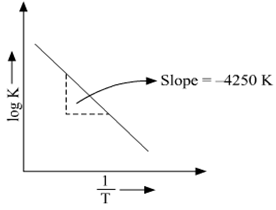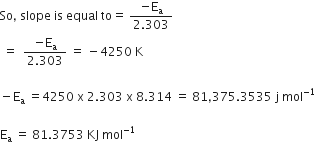 Long Answer Type
Long Answer Type
For the hydrolysis of methyl acetate in aqueous solution, the following results were obtained:
|
t/s |
0 |
30 |
60 |
|
[CH3COOCH3] / mol L–1 |
0.60 |
0.30 |
0.15 |
(i) Show that it follows pseudo-first order reaction, as the concentration of water remains constant.
(ii) Calculate the average rate of reaction between the time intervals 30 to 60 seconds.
(Given log 2 = 0.3010, log 4 = 0.6021)
 Short Answer Type
Short Answer TypeFor a reaction A + B → P, the rate is given by Rate = k[A] [B]2
(i) How is the rate of reaction affected if the concentration of B is doubled?
(ii) What is the overall order of reaction if A is present in large excess?
A first order reaction takes 30 minutes for 50% completion. Calculate the time required for 90% completion of this reaction.
(log 2 = 0.3010)
The following data were obtained during the first-order thermal decomposition of SO2Cl2 at a constant volume:
SO2Cl2(g)---> SO2(g) + Cl2(g)
|
Experiment |
Time/s-1 |
Total pressure/atm |
|
1 |
0 |
0.4 |
Calculate the rate constant. (Given : log 4 = 0.6021, log 2 = 0.3010)
A reaction is second order in A and first order in B.
(i) Write the differential rate equation.
(ii) How is the rate affected on increasing the concentration of A three times?
(iii) How is the rate affected when the concentrations of both A and B are doubled?
A first order reaction takes 40 minutes for 30% decomposition. Calculate t1/2 for this reaction.
(Given log 1.428 = 0.1548)
For a first order reaction, show that time required for 99% completion is twice the time required for the completion of 90% of reaction.
 Long Answer Type
Long Answer TypeRate constant ‘k’ of a reaction varies with temperature ‘T’ according to the equation:
![]()
where Ea is the activation energy.
When a graph is plotted for ![]() a straight line with a slope of -4250 K is obtained. Calculate ‘Ea’ for the reaction.
a straight line with a slope of -4250 K is obtained. Calculate ‘Ea’ for the reaction.
(R = 8.314 JK-1 mol-1)
![]()
Ea --> Activation energy
The above equation is like y = mx + c where if we plot y v/s x we get a straight line with slope ‘m’ and intercept ‘c’.


